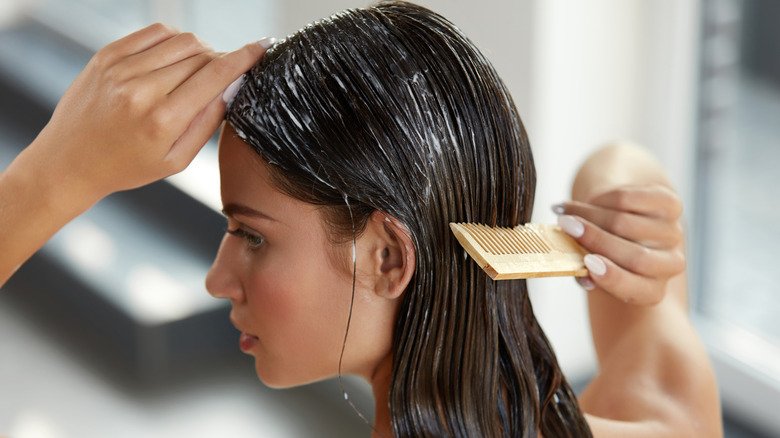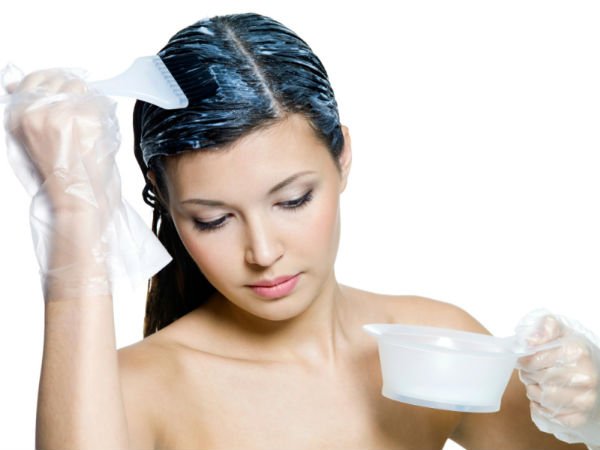Are you tired of dealing with dry, brittle, and unmanageable hair? Does the mere thought of running your fingers through your hair make you cringe as it feels like a straw?
Dry hair is a common concern that plagues many of us, but the good news is that you don’t have to live with it. With the right knowledge and care, you can restore your hair’s natural moisture, shine, and softness.
In this comprehensive guide, we will delve into the world of dry hair and uncover the secrets to transforming it into a lush mane of beauty.
The Root causes of dry hair
Dry hair is more than just a cosmetic concern; it’s a reflection of your hair’s overall health. To effectively address the problem, it’s essential to understand what causes dryness in the first place.
1. Lack of Natural Oils: Hair becomes dry when it doesn’t retain or produce enough natural oils, particularly sebum. These oils are essential for keeping your hair well-hydrated and protected. Various factors can lead to reduced sebum production, including genetics, age, and hormonal changes.
2. Environmental Factors: External conditions play a significant role in hair dryness. Prolonged exposure to sun, wind, and extreme weather conditions can strip your hair of its moisture, leaving it parched and vulnerable.
3. Overuse of Styling Products: Frequent use of hair styling products like heat tools, gels, and hairsprays can lead to product buildup, making it difficult for your hair to absorb and retain moisture.
4. Harsh Hair Care Practices: Aggressive hair care practices such as excessive shampooing, using hot water, or rough towel-drying can strip your hair of its natural oils and contribute to dryness.
5. Diet and Hydration: Your overall health, diet, and hydration levels are also closely tied to the condition of your hair. A balanced diet that includes essential nutrients and adequate water intake can help maintain your hair’s moisture.
6. Chemical Treatments: Frequent hair coloring, perming, and chemical straightening can damage the hair’s cuticle layer, making it more prone to dryness and breakage.
Types of Dry Hair
- Dry Scalp, Oily Ends: This type of dry hair often occurs when the scalp lacks moisture, leading to dry, itchy skin. At the same time, the hair ends may remain oily, creating an imbalance.
- Overall Dryness: Some individuals experience dryness throughout their hair, from the scalp to the tips. This can result from various factors, including environmental conditions, genetics, and hair care habits.
- Chemically Damaged Dry Hair: Hair that has undergone frequent chemical treatments such as coloring, perming, or straightening can become excessively dry and brittle due to the damage inflicted on the hair’s structure.
- Aging Dry Hair: As we age, our bodies produce fewer natural oils, which can contribute to drier hair. Gray hair, in particular, can be more prone to dryness and frizz.
How to moisturize dry hair
With the right knowledge and care, you can restore your hair’s natural moisture, shine, and softness. Below explained proven treatments will surely restore and preserve the moisture in your hair strands.
#1. Pre-Conditioning Before Washing
Pre-conditioning is a crucial step, especially for individuals with dry and damaged hair. It involves applying a nourishing treatment to your hair before shampooing to prepare it for the cleansing process while minimizing moisture loss.

The Benefits of Pre-Conditioning
- Moisture Retention: Pre-conditioning helps create a protective barrier on your hair, preventing the shampoo from stripping away all the natural oils and moisture. This is particularly important for dry hair that is prone to dehydration.
- Detangling: Applying a pre-conditioner can help to detangle your hair, making it easier to manage during the washing and conditioning process. This is especially beneficial for those with curly or oily hair.
- Reduced Frizz: Pre-conditioning can minimize frizz and promote a smoother hair texture, making it easier to style after washing.
Simple step-by-step guide to pre-conditioning
Step 1: Choose the Right Pre-Conditioner
Select a pre-conditioning product that suits your hair type and needs. You can use a commercial pre-conditioner or opt for natural ingredients like coconut oil, olive oil, or aloe vera gel.
Step 2: Dampen Your Hair
Before applying the pre-conditioner, dampen your hair with lukewarm water. This helps to open the hair cuticle, making it more receptive to the treatment.
Step 3: Apply the Pre-Conditioner
Generously apply the pre-conditioner to your hair, focusing on the ends and any particularly dry or damaged areas. Make sure to distribute it evenly and use a wide-tooth comb to detangle your hair gently.
Step 4: Leave it In
Leave the pre-conditioner in your hair for at least 15-30 minutes. You can also cover your hair with a shower cap or a warm, damp towel to create a more intense treatment.
Step 5: Shampoo and ConditionAfter pre-conditioning, proceed to shampoo your hair as usual, followed by a moisturizing conditioner. Make sure to rinse thoroughly.
#2. Choose moisturizing conditioners and shampoos
Selecting the right moisturizing conditioner and shampoo is a crucial step in the journey to combat dry hair. These products play a pivotal role in adding and retaining moisture in your hair. In this section, we’ll explore what to look for in moisturizing hair care products, how to choose them based on your hair type, and some recommended products.

What to Look for in Moisturizing Conditioners and Shampoos
- Hydrating Ingredients: Opt for products that contain moisturizing ingredients such as glycerin, hyaluronic acid, shea butter, aloe vera, and natural oils like coconut, argan, and jojoba. These ingredients help replenish and lock in moisture.
- Sulfate-Free: Sulfates, such as sodium lauryl sulfate, can be harsh and strip the hair of its natural oils. Look for sulfate-free products to ensure a gentle cleansing process that won’t further dehydrate your hair.
- Paraben-Free: Parabens are preservatives that can be harmful in the long run. Choose products without parabens to prevent potential damage to your hair.
- pH-Balanced: pH-balanced shampoos and conditioners are designed to match the natural pH of your hair and scalp. This helps to maintain the health of your hair and prevent excessive dryness.
- Protein-Infused: If your hair is not only dry but also damaged, consider products containing hydrolyzed proteins. These proteins can help repair and strengthen your hair.
- Labeling for Your Hair Type: Some products are specifically labeled for certain hair types, such as “for dry or damaged hair” or “for curly hair.” These can be helpful indicators.
- Natural or Organic Options: If you prefer natural products, explore lines that offer all-natural or organic conditioners and shampoos. These products often contain fewer synthetic chemicals and are gentler on your hair.
Choosing Products Based on Your Hair Type
- Dry and Damaged Hair: If your hair is both dry and damaged, look for deeply moisturizing conditioners and shampoos with repairing properties. Consider products with ingredients like argan oil, shea butter, and keratin.
- Curly or Coily Hair: Curly and oily hair tends to be naturally drier due to the shape of the strands, which makes it more challenging for natural oils to travel down the hair. Choose products specifically designed for curly hair, often labeled as “curl-enhancing” or “for frizz control.”
- Fine or Thin Hair: Fine or thin hair can become weighed down by heavy products. Opt for lightweight, volumizing conditioners and shampoos that provide moisture without causing your hair to look flat.
- Color-Treated Hair: If you’ve dyed your hair, choose color-safe products to preserve the vibrancy of your color. These products often contain ingredients that protect against color fading while hydrating the hair.
#3. Use deep nourishing hair serum
These serums are packed with potent ingredients designed to provide intense hydration, repair damaged strands, and create a protective barrier to prevent moisture loss. In this section, we’ll explore the benefits of using a deep nourishing hair serum, how to apply it, and some recommended serums to consider.

The Benefits of Deep Nourishing Hair Serum
- Intense Hydration: Hair serums are formulated with moisturizing ingredients like natural oils (argan, coconut, jojoba), shea butter, and vitamins (E and B5) to deeply hydrate and condition your hair.
- Damage Repair: Many serums contain repairing elements that help mend split ends and strengthen damaged hair, making it more resilient against future damage.
- Frizz Control: Hair serums can combat frizz and provide a sleek, smooth appearance to your hair, even in humid conditions.
- Heat Protection: Some serums act as heat protectants, shielding your hair from the damaging effects of styling tools like hairdryers and straighteners.
- Tangle Prevention: Using a serum can make detangling easier, especially for those with long or curly hair.
How to Apply a Deep Nourishing Hair Serum
- Start with Clean, Towel-Dried Hair: After shampooing and conditioning your hair, gently towel-dry it until it’s damp but not soaking wet.
- Dispense a Small Amount: Depending on your hair’s length and thickness, dispense a small amount of the serum into your palm. It’s essential not to overdo it, as using too much serum can make your hair greasy.
- Rub Between Your Palms: Rub the serum between your palms to evenly distribute it.
- Apply to Hair: Run your hands through your hair, concentrating on the mid-lengths and ends. Avoid applying the serum directly to the scalp, as it can make your hair look greasy.
- Comb or Brush Through Gently comb or brush your hair to ensure even distribution and to help detangle any knots.
- Style as Desired: Style your hair as usual. If you’re using heat tools, ensure the serum you’ve chosen offers heat protection.
#4. Deep conditioning overnight
For those seeking a powerful and long-lasting solution to dry and damaged hair, deep conditioning overnight can be a game-changing technique. This extended treatment allows for maximum absorption of moisture and nutrients, leaving your hair deeply hydrated, soft, and revitalized.

This intensive treatment allows for the thorough absorption of hydrating and restorative ingredients, leaving your hair soft, shiny, and healthier than ever.
The Benefits of Overnight Deep Conditioning
- Intense Hydration: Overnight deep conditioning permits your hair to absorb the full spectrum of moisturizing elements, essential oils, and nutrients contained within your chosen conditioner.
- Repair and Strengthen: This extended treatment is designed to mend damaged hair by reinforcing its structure and reducing breakage. It enhances your hair’s strength and elasticity.
- Frizz Control: Overnight deep conditioning can eliminate frizz, rendering your hair smoother and shinier.
- Manageability: Your hair becomes more manageable, making it easier to style and detangle.
How to Deep Condition Overnight
- Start with Clean Hair: Initiate the process by cleansing your hair with a mild, sulfate-free shampoo. This ensures that any dirt or product buildup is removed, enabling the deep conditioner to penetrate your hair effectively.
- Towel-Dry Your Hair: Gently blot your hair with a towel to eliminate excess moisture. Your hair should be damp but not dripping wet.
- Apply the Deep Conditioner: Apply a generous amount of your chosen deep conditioner to your hair. Concentrate primarily on the mid-lengths and ends, which are typically the most dehydrated. If you have an oily scalp, refrain from applying conditioner to the roots.
- Evenly Distribute the Conditioner: Utilize a wide-tooth comb or your fingers to evenly distribute the conditioner, making sure it reaches every strand.
- Secure Your Hair: Carefully gather your conditioned hair and secure it in a loose bun, braid, or bun (for those with long hair). This helps prevent the conditioner from transferring onto your bedding.
- Cover Your Hair: Employ a shower cap or plastic wrap to cover your conditioned hair. This creates a warm, sealed environment that facilitates optimal absorption.
- Protect Your Pillow: To prevent staining your pillow, use an old pillowcase or cover it with a towel or cloth.
- Leave it Overnight: Allow the deep conditioner to work its magic while you sleep. The duration can vary, but a minimum of 6-8 hours is ideal for reaping the maximum benefits. Overnight is the most convenient time for this treatment.
- Rinse and Style: In the morning, rinse your hair thoroughly with cool water. Follow with your regular shampoo and conditioner to eliminate any residual product. Style your hair as desired.
#5. Use natural plant oils

Natural plant oils have been used for centuries to improve hair health, promote hydration, and add a radiant shine. In this section, we’ll explore the benefits of various plant oils, how to use them, and provide a list of some popular choices for maintaining well-moisturized hair.
Popular Natural Plant Oils for Hair Hydration
- Coconut Oil: Known for its deep conditioning properties, coconut oil is highly effective in penetrating the hair shaft, preventing protein loss, and reducing hair porosity.
- Argan Oil: Often referred to as “liquid gold,” argan oil is rich in vitamins and antioxidants. It is excellent for adding shine and controlling frizz.
- Olive Oil: Olive oil is a readily available and affordable option that can deeply moisturize and improve hair strength.
- Jojoba Oil: Jojoba oil closely resembles the natural sebum produced by the scalp. It is lightweight and ideal for promoting a healthy scalp and moisturizing the hair.
- Avocado Oil: Rich in vitamins A, D, and E, avocado oil can help hydrate and repair damaged hair.
- Sweet Almond Oil: This oil is excellent for detangling and adding softness to dry, brittle hair.
- Castor Oil: Known for its ability to promote hair growth, castor oil can also provide deep hydration and prevent breakage.
- Rosehip Oil: Rosehip oil is packed with essential fatty acids and antioxidants, making it a great choice for nourishing dry and damaged hair.
Additional tips on how to moisturize dry hair
Here are some additional tips to help you maintain well-moisturized hair:
1. Drink Plenty of Water: Hydrating your body from the inside out is crucial for healthy hair. Aim to drink enough water daily to keep your hair and scalp adequately moisturized.
2. Maintain a Balanced Diet: Nutrient-rich foods, including those high in vitamins, minerals, and healthy fats, play a significant role in the overall health of your hair. Incorporate foods like salmon, nuts, leafy greens, and sweet potatoes into your diet.
Limit Heat Styling: Excessive heat styling can lead to dryness and damage. Whenever possible, allow your hair to air-dry and minimize the use of hot styling tools. If you must use them, apply a heat protectant.
4. Use Silk or Satin Pillowcases: These materials are gentler on your hair than cotton, reducing friction and preventing moisture loss while you sleep.
5. Don’t Overwash Your Hair: Washing your hair too frequently can strip away its natural oils. Consider spacing out your wash days and using a dry shampoo in between to keep your hair feeling fresh.
6. Trim Regularly: Getting regular trims (every 6-8 weeks) can help remove split ends and prevent further damage, resulting in healthier and more hydrated hair.
7. Protect Your Hair from the Sun: Just as your skin needs sun protection, so does your hair. Use hair products with UV protection or wear a hat when spending time in the sun to shield your hair from UV damage.
8. Avoid Tight Hairstyles: Styles that pull and strain your hair, such as tight ponytails or braids, can lead to breakage and damage. Opt for looser, more gentle styles to preserve your hair’s health.
9. Reduce Stress: High stress levels can negatively affect your hair. Incorporate stress-reduction techniques like meditation, yoga, or deep breathing exercises into your daily routine.
Experiment with Natural Hair Masks: Besides deep conditioning, try homemade hair masks with ingredients like honey, yogurt, or avocado to provide your hair with extra nourishment.
11. Be Gentle When Detangling: Use a wide-tooth comb or a detangling brush to gently work through knots and tangles. Start from the tips and work your way up to the roots to minimize damage.
12. Monitor the Water Temperature: Hot water can be harsh on your hair and scalp, causing dryness. Use lukewarm or cool water when washing your hair to maintain moisture.
13. Be Patient: Achieving and maintaining well-moisturized hair takes time and consistent care. Be patient with your hair, and don’t expect instant results. Your efforts will pay off in the long run.
Frequently asked questions
1. Why is my hair so dry, and what causes it?
- Dry hair can result from various factors, including genetics, environmental conditions, overuse of styling products, harsh hair care practices, poor diet, and chemical treatments. Understanding the cause is essential for effective treatment.
2. How often should I deep condition my hair?
- The frequency of deep conditioning depends on your hair type and its specific needs. In general, once a week to once a month is recommended. Adjust the frequency based on the condition of your hair.
3. Can I over-moisturize my hair?
- Yes, it’s possible to over-moisturize your hair, which can lead to a limp, greasy appearance. It’s essential to strike a balance and adjust your hair care routine based on your hair’s response.
4. What’s the best way to choose the right shampoo and conditioner for dry hair?
- Look for sulfate-free, paraben-free, and hydrating products. Choose based on your specific hair type and concerns, such as dry, curly, or color-treated hair.
5. How can I prevent split ends and breakage in dry hair?
- Regular trims, minimal heat styling, using a wide-tooth comb, and applying protective serums can help prevent split ends and breakage in dry hair.
6. Are natural plant oils suitable for all hair types?
- While natural plant oils are generally safe for various hair types, it’s essential to select an oil that suits your specific needs. Coconut, argan, and jojoba oils are versatile options, but tailor your choice to your hair type.
7. Can I deep condition my hair overnight every time I wash it?
- Deep conditioning overnight is beneficial, but it’s not necessary every time you wash your hair. Overdoing it can lead to product buildup.
Wrapping up
From pre-conditioning and choosing the right moisturizing shampoos and conditioners to using deep nourishing hair serums, and practicing overnight deep conditioning, we’ve explored various methods to infuse moisture into your hair. We’ve also highlighted the power of natural plant oils in achieving hydration and provided tips and answers to common questions to help you on your journey to healthier, more moisturized hair.
Remember that achieving well-hydrated hair is a journey that requires patience and consistency. What works for one person may not work for another, so don’t be discouraged if you need to experiment with different techniques and products to find what suits you best.
Ultimately, the key to successful hair hydration lies in understanding your hair’s unique needs, maintaining a balanced and nourishing hair care routine, and practicing good overall health habits. By following the tips and techniques outlined in this guide and tailoring them to your specific requirements, you can look forward to enjoying hair that is not only well-moisturized but also radiantly healthy. So, go forth and embrace the journey to hair that shines with vitality and moisture!



